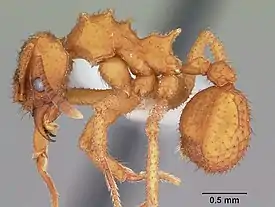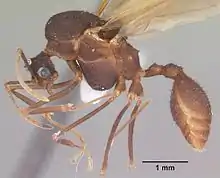Mycetomoellerius
Mycetomoellerius (лат.) — род муравьёв-грибководов трибы Attini из подсемейства мирмицины. Включает около 30 видов, которые ранее включались в состав рода Trachymyrmex. Род назван в честь немецкого миколога Альфреда Мёллера (Alfred Möller, 1860—1922), который в 1890—1893 годах в Бразилии провёл первые подробные исследования муравьёв-грибководов[1].
| Mycetomoellerius | ||||||
|---|---|---|---|---|---|---|
 Mycetomoellerius turrifex | ||||||
| Научная классификация | ||||||
|
Домен: Царство: Подцарство: Без ранга: Без ранга: Без ранга: Без ранга: Тип: Подтип: Надкласс: Класс: Подкласс: Инфракласс: Надотряд: Hymenopterida Отряд: Подотряд: Инфраотряд: Надсемейство: Семейство: Подсемейство: Триба: Род: Mycetomoellerius |
||||||
| Международное научное название | ||||||
| Mycetomoellerius Solomon et al., 2019 | ||||||
| Типовой вид | ||||||
|
Trachymyrmex iheringi (Emery, 1888) |
||||||
| Виды | ||||||
|
См. статью (около 30 видов) |
||||||
| ||||||
Распространение
Род характерен исключительно для Нового Света, большая часть видов встречается в неотропической части Южной Америки (22 вида); 5 видов — в Центральной Америке (M. isthmicus, M. opulentus, M. squamulifer, M. turrifex, M. zeteki); 3 вида — на Карибских островах (M. haytianus, M. jamaicensis, M. jamaicensis antiguensis), и 2 вида (M. jamaicensis, M. turrifex) в Северной Америке (Мексика, США)[1][2].
Описание
От близких родов (Paratrachymyrmex, Trachymyrmex) отличается гладкими мандибулами; преокулярные и фронтальные бороздки субпараллельны, продолжаются до заднего края головы. Мелкие мономорфные муравьи (рабочие около 5 мм); крупные рабочие и солдаты отсутствуют. Тело покрыто выступами-туберкулами и многочисленными изогнутыми волосками. От других родов муравьёв-грибководов отличается тем, что их грудные выступы на дорзуме пронотума и мезонотума окружены вторичными туберкулами или мелкими шипиками, которые у некоторых видов трансформируются в мелкие бугорки. Усики состоят из 11 члеников, без явной булавы. Формула щупиков: 4,2. Тело покрыто многочисленными бугорками (каждый с волоском) и шипиками. Стебелёк между грудкой и брюшком состоит из двух члеников: петиолюса и постпетиолюса (последний чётко отделён от брюшка), жало развито, куколки голые (без кокона)[1][2][3].
Характерны своим тесным симбиозом с грибами, выращиваемыми в муравейниках. Гнездо состоит из нескольких ячеек-камер, расположенных вертикально в почве. В качестве субстрата для грибницы используют фекалии насекомых, кусочки фруктов и другие остатки мёртвых растений[1][4].
Известен один ископаемый вид: †Mycetomoellerius primaevus (Baroni Urbani, 1980), Доминиканский янтарь, миоцен[1][5].
 Крылатый самец Mycetomoellerius jamaicensis
Крылатый самец Mycetomoellerius jamaicensis Mycetomoellerius dichrous
Mycetomoellerius dichrous Mycetomoellerius kempfi
Mycetomoellerius kempfi
Генетика
Диплоидный набор хромосом: Mycetomoellerius fuscus — 2n = 18 (n = 9) 16M + 2SM[6], Mycetomoellerius holmgreni — 20 (10) 20M[7], Mycetomoellerius relictus — 20 (10) 20M[8], Mycetomoellerius iheringi — 20 (10) 18M + 2SM[9].
Систематика
Род включает около 30 видов, которые ранее включались в состав рода Trachymyrmex. Таксон Mycetomoellerius впервые был выделен в 2019 году, когда в результате молекулярно-генетического анализа род Trachymyrmex был разделён на три: Mycetomoellerius (бывшая видовая группа Iheringi group), Paratrachymyrmex Solomon et al., 2019 (бывшая видовая группа Intermedius group) и собственно Trachymyrmex (типовой вид Trachymyrmex septentrionalis McCook, 1881))[1]. Из муравьёв-грибководов наиболее близок к родам Paratrachymyrmex, Trachymyrmex, Acromyrmex и Mycetosoritis, у которых на первом тергите брюшка также развиты туберкулы[1][2][10][11].
- Mycetomoellerius agudensis Kempf, 1967[12]
- Mycetomoellerius atlanticus Mayhé-Nunes & Brandao, 2007[11]
- Mycetomoellerius cirratus Mayhé-Nunes & Brandão, 2005[10]
- Mycetomoellerius compactus Mayhé-Nunes & Brandão, 2002[2]
- Mycetomoellerius dichrous Kempf, 1967
- Mycetomoellerius echinus Weber, 1938
- Mycetomoellerius farinosus (Emery, 1894)
- Mycetomoellerius fiebrigi (Santschi, 1916)
- Mycetomoellerius gaigei (Forel, 1914)
- Mycetomoellerius guianensis Weber, 1937
- Mycetomoellerius haytianus Wheeler & Mann, 1914
- Mycetomoellerius holmgreni Wheeler, 1925
- Mycetomoellerius iheringi (Emery, 1888) typus
- Mycetomoellerius isthmicus Santschi, 1931
- Mycetomoellerius ixyodus Mayhé-Nunes & Brandao, 2007[11]
- Mycetomoellerius jamaicensis (Andre, 1893)
- = Trachymyrmex sharpii Forel, 1893; Trachymyrmex maritimus Wheeler, 1905
- Trachymyrmex jamaicensis antiguensis Weber, 1938 (возможно, отдельный вид, см. Mayhé‐Nunes & Brandão, 2007)[11]
- Mycetomoellerius kempfi Fowler, 1988
- Mycetomoellerius mikromelanos Cardenas, Schultz, & Adams, 2021[13]
- Mycetomoellerius oetkeri (Forel, 1908)
- Mycetomoellerius opulentus (Mann, 1922)
- Mycetomoellerius papulatus Santschi, 1922
- †Mycetomoellerius primaevus Baroni Urbani, 1980
- Mycetomoellerius pruinosus (Emery, 1906)
- Mycetomoellerius relictus Borgmeier, 1934
- Mycetomoellerius ruthae Weber, 1937
- Mycetomoellerius squamulifer (Emery, 1896)
- Mycetomoellerius tucumanus (Forel, 1914)
- Mycetomoellerius turrifex (Wheeler, 1903)
- Mycetomoellerius urichii (Forel, 1893)
- = Mycetomoellerius fuscus Emery, 1894[14]
- Mycetomoellerius verrucosus Borgmeier, 1948
- Mycetomoellerius zeteki Weber, 1940
Примечания
- Scott E. Solomon, Christian Rabeling, Jeffrey Sosa‐Calvo, Cauê T. Lopes, André Rodrigues, Heraldo L. Vasconcelos, Maurício Bacci Jr, Ulrich G. Mueller, Ted R. Schultz. (2019). The molecular phylogenetics of Trachymyrmex Forel ants and their fungal cultivars provide insights into the origin and coevolutionary history of ‘higher‐attine’ ant agriculture. «Systematic Entomology». 2019. Vol.44, 4, pp. 939—956. Ссылка. https://doi.org/10.1111/syen.12370
- Mayhé-Nunes A. J. & C. R. F. Brandão. 2002: Revisionary studies on the attine ant genus Trachymyrmex Forel. Part 1: Definition of the genus and the opulentus group (Hymenoptera: Formicidae). — Sociobiology, 40(3): 667—698.
- Rabeling, C., S. P. Cover, R. A. Johnson, and U. G. Mueller. A review of the North American species of the fungus-gardening ant genus Trachymyrmex (Hymenoptera : Formicidae) (англ.) // Zootaxa : Журнал. — Auckland, New Zealand: Magnolia Press, 2007. — Vol. 1664. — P. 1—53. — ISSN 1175-5326.
- Hölldobler B., Wilson E. O. The Ants. — Harvard University Press, 1990. — P. 606. — 732 p. — ISBN 0674040759.
- Baroni Urbani, C. 1980: First description of fossil gardening ants. (Amber collection Stuttgart and Natural History Museum Basel; Hymenoptera: Formicidae. I: Attini.) Stuttgarter Beitraege zur Naturkunde, (B)54: 1—13.
- Barros LAC, Aguiar HJAC, Mariano CSF, Delabie JHC, Pompolo SG (2013a) Cytogenetic characterization of the ant Trachymyrmex fuscus Emery, 1934 (Formicidae: Myrmicinae: Attini) with the description of a chromosomal polymorphism. Annales de la Société Entomologique de France 49: 367—373. https://doi.org/10.1080/00379271.2013.856201
- Barros LAC, Teixeira GA, Aguiar HJAC, Lopes DM, Pompolo SG (2018) Cytogenetic studies in Trachymyrmex holmgreni Wheeler, 1925 (Formicidae: Myrmicinae) by conventional and molecular methods. Sociobiology 65: 185—190. https://doi.org/10.13102/sociobiology.v65i2.2214
- Barros LAC, Mariano CSF, Pompolo SG (2013b) Cytogenetic studies of five taxa of the tribe Attini (Formicidae: Myrmicinae). Caryologia 66: 59-64. https://doi.org/10.1080/00087 114.2013.780443
- Micolino R., Cristiano M.P., Cardoso D.C. (2020). Karyotype and putative chromosomal inversion suggested by integration of cytogenetic and molecular data of the fungus-farming ant Mycetomoellerius iheringi Emery, 1888. Comparative Cytogenetics 14(2): 197—210. https://doi.org/10.3897/CompCytogen.v14i2.49846
- Mayhé-Nunes A. J. & C. R. F. Brandão. 2005: Revisionary studies on the attine ant genus Trachymyrmex Forel. Part 2: The Iheringi group (Hymenoptera: Formicidae). — Sociobiology, 45(2): 271—305.
- Mayhé-Nunes A. J. & C. R. F. Brandão. 2007: Revisionary studies on the attine ant genus Trachymyrmex Forel. Part 3: The Jamaicensis group (Hymenoptera: Formicidae). — Zootaxa, 1444: 1—21.
- Kempf W. W. 1967: New ants from southeastern and central Brazil (Hymenoptera, Formicidae). — Studia Entomologica (N.S.), 9: 121—128.
- Cardenas CR, Luo AR, Jones TH, Schultz TR, Adams RMM. 2021. Using an integrative taxonomic approach to delimit a sibling species, Mycetomoellerius mikromelanos sp. nov. (Formicidae: Attini: Attina) PeerJ 9:e11622 pp.1-39. https://doi.org/10.7717/peerj.11622
- Micolino R, Cristiano MP, Travenzoli NM, Lopes DM, Cardoso DC (2019) Chromosomal dynamics in space and time: evolutionary history of Mycetophylax ants across past climatic changes in the Brazilian Atlantic coast. Scientific Reports 9(18800): 1–13. https://doi.org/10.1038/s41598-019-55135-5
Литература
- Bolton B. A new general catalogue of the ants of the world, Harvard University Press, Cambridge, MA, 1995.
- Mayhé-Nunes A. J. & C. R. F. Brandão. 2002: Revisionary studies on the attine ant genus Trachymyrmex Forel. Part 1: Definition of the genus and the opulentus group (Hymenoptera: Formicidae). — Sociobiology, 40(3): 667—698.
- Mayhé-Nunes A. J. & C. R. F. Brandão. 2005: Revisionary studies on the attine ant genus Trachymyrmex Forel. Part 2: The Iheringi group (Hymenoptera: Formicidae). — Sociobiology, 45(2): 271—305.
- Mayhé-Nunes A. J. & C. R. F. Brandão. 2007: Revisionary studies on the attine ant genus Trachymyrmex Forel. Part 3: The Jamaicensis group (Hymenoptera: Formicidae). — Zootaxa, 1444: 1-21.
- Weber N. A. 1945: The biology of the fungus-growing ants. Part 8. The Trinidad, B.W.I. species. — Revista de Entomologia, São Paulo, 16: 1-88.